Browse our Growing Library of Success Stories
By:
Gregg Elliott When Heather Dutton, fresh out of undergraduate school at the Warner College of Natural Resources and graduate school in the College of Agriculture at Colorado State University, began her first job working for a non-profit river restoration organization in the San Luis Valley, she was thrilled. She also felt confident that her technical training in restoration ecology had prepared her for the challenges she’d soon be facing.
When Heather Dutton, fresh out of undergraduate school at the Warner College of Natural Resources and graduate school in the College of Agriculture at Colorado State University, began her first job working for a non-profit river restoration organization in the San Luis Valley, she was thrilled. She also felt confident that her technical training in restoration ecology had prepared her for the challenges she’d soon be facing.
Heather was in for a surprise.
By:
Leopold Conservation Award Program J. David Bamberger’s Selah, Bamberger Ranch Preserve stands as a motivating symbol of the power of private landowner conservation.
J. David Bamberger’s Selah, Bamberger Ranch Preserve stands as a motivating symbol of the power of private landowner conservation.
By:
Leopold Conservation Award Program Land stewardship is about balance. If a ranch is managed solely for the purpose of grazing cattle, the rest of its ecosystem falls out of balance. Hugh Fitzsimons Jr. embraced a more holistic approach at his San Pedro Ranch in the 1970s. He believed if you improved native habitat, the ecosystem would not only lead to more wildlife, but to healthier livestock.
Land stewardship is about balance. If a ranch is managed solely for the purpose of grazing cattle, the rest of its ecosystem falls out of balance. Hugh Fitzsimons Jr. embraced a more holistic approach at his San Pedro Ranch in the 1970s. He believed if you improved native habitat, the ecosystem would not only lead to more wildlife, but to healthier livestock.
By:
Natural Resources Conservation Service This video is the story of a young scientist, Hugh Hammond Bennett, who recognized 80 years ago that the United States was at risk of losing it’s most important resource – its soil. He made it his mission to change the trajectory of agriculture at a time of great crisis and to provide farmers and ranchers with the information and tools they needed to be sustainable.
This video is the story of a young scientist, Hugh Hammond Bennett, who recognized 80 years ago that the United States was at risk of losing it’s most important resource – its soil. He made it his mission to change the trajectory of agriculture at a time of great crisis and to provide farmers and ranchers with the information and tools they needed to be sustainable.
This 21 minute video is the story of the conservation movement that Hugh Hammond Bennett began and includes interesting insights into the policies and structures that he set up that we continue to rely on today. His work revealed so much of what we’re rediscovering and renaming as “regenerative agriculture.”
By:
Washington Policy Center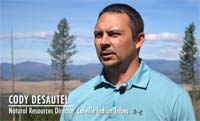 This video from Washington Policy Center with cooperation from the Confederated Tribes of the Colville Reservation, sheds light on how the tribes manage forests to be more healthy using commercial harvests, thinnings, and controlled burns to deal with the pressures of insect infestation, climate change, and decades of fire suppression.
This video from Washington Policy Center with cooperation from the Confederated Tribes of the Colville Reservation, sheds light on how the tribes manage forests to be more healthy using commercial harvests, thinnings, and controlled burns to deal with the pressures of insect infestation, climate change, and decades of fire suppression.
By:
Steve Stuebner Before knowing much about land trusts, Ashton farmer John Nedrow thought they were some kind of sinister force seeking to take over his farm and force landowners off their property.
Before knowing much about land trusts, Ashton farmer John Nedrow thought they were some kind of sinister force seeking to take over his farm and force landowners off their property.
“Back then, I thought they were the enemy,” Nedrow said in an interview on his alfalfa and malt-barley farm, which straddles the banks of the famed Henrys Fork River, a blue-ribbon trout stream. “I thought they wanted to turn this whole area into national park.”
 Their introduction to holistic ranch management techniques called into question long-held, traditional ways of thinking. The drastic changes that followed required a leap of faith for the fourth-generation ranchers. They traded harvesting hay for grazing methods that let their cattle harvest the forage themselves. Such changes didn’t happen overnight, and each came with its own risk and learning curve.
Their introduction to holistic ranch management techniques called into question long-held, traditional ways of thinking. The drastic changes that followed required a leap of faith for the fourth-generation ranchers. They traded harvesting hay for grazing methods that let their cattle harvest the forage themselves. Such changes didn’t happen overnight, and each came with its own risk and learning curve.
By:
Texas Parks and Wildlife Foundation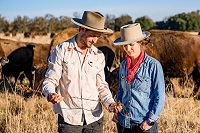 Taylor Collins’ and Katie Forrest’s life journey has taken them from restoring their bodies to restoring their land. The once-vegetarian Austin couple went vegan after health issues got in the way of sports training. When things got worse, they consulted a nutritionist who urged them to add clean meat protein to their diet.
Taylor Collins’ and Katie Forrest’s life journey has taken them from restoring their bodies to restoring their land. The once-vegetarian Austin couple went vegan after health issues got in the way of sports training. When things got worse, they consulted a nutritionist who urged them to add clean meat protein to their diet.
By:
National Geographic Almost 50 years ago, fried chicken tycoon David Bamberger used his fortune to purchase 5,500 acres of overgrazed land in the Texas Hill Country. Planting grasses to soak in rains and fill hillside aquifers, Bamberger devoted the rest of his life to restoring the degraded landscape. Today, the land has been restored to its original habitat and boasts enormous biodiversity. Bamberger's model of land stewardship is now being replicated across the region and he is considered to be a visionary in land management and water conservation.
Almost 50 years ago, fried chicken tycoon David Bamberger used his fortune to purchase 5,500 acres of overgrazed land in the Texas Hill Country. Planting grasses to soak in rains and fill hillside aquifers, Bamberger devoted the rest of his life to restoring the degraded landscape. Today, the land has been restored to its original habitat and boasts enormous biodiversity. Bamberger's model of land stewardship is now being replicated across the region and he is considered to be a visionary in land management and water conservation.
By:
K. Gregg Elliott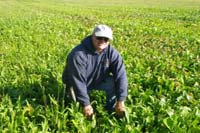 Like almost everyone else in his rural community, Gabe had been farming and ranching using conventional methods since purchasing his Brown’s Ranch from the parents of his wife Shelly in 1991. Possibly because he had not grown up on a farm, Gabe found that he was constantly asking the question, “why do we do things this way?”
Like almost everyone else in his rural community, Gabe had been farming and ranching using conventional methods since purchasing his Brown’s Ranch from the parents of his wife Shelly in 1991. Possibly because he had not grown up on a farm, Gabe found that he was constantly asking the question, “why do we do things this way?”
By:
Northwest Florida Water Management District On March 2, 2018, a large prescribed burn occurred at the Yellow River Water Management Area in Santa Rosa County, Florida, which is managed by the Northwest Florida Water Management District. Weather and atmospheric conditions were ideal and resources were available for the Florida Forest Service to approve the burn permit. Aerial ignition via helicopter started the fire systematically across the landscape. Ground firing and monitoring crews, consisting of 15 personnel were stationed at the tract perimeter as ground support during the burn.
On March 2, 2018, a large prescribed burn occurred at the Yellow River Water Management Area in Santa Rosa County, Florida, which is managed by the Northwest Florida Water Management District. Weather and atmospheric conditions were ideal and resources were available for the Florida Forest Service to approve the burn permit. Aerial ignition via helicopter started the fire systematically across the landscape. Ground firing and monitoring crews, consisting of 15 personnel were stationed at the tract perimeter as ground support during the burn.
By:
USDA Forest Service Over four long days in late March 2011, the most severe wildfire outbreak in a decade occurred at Eglin Air Force Base, located near Destin, Florida (Fig. 1). A persistent drought, 20 mph winds and low humidity, combined with 12-15 arson fires on the property, resulted in 6,000 acres burned in a matter of days. Due to Eglin’s aggressive prescribed fire program, the March 2011 wildfire severity and acres burned were significantly reduced. Without this regular fuel reduction, anywhere from 10-12,000 acres could have burned just on the Eglin side, with untold acres burned and property damaged north of Interstate 10.
Over four long days in late March 2011, the most severe wildfire outbreak in a decade occurred at Eglin Air Force Base, located near Destin, Florida (Fig. 1). A persistent drought, 20 mph winds and low humidity, combined with 12-15 arson fires on the property, resulted in 6,000 acres burned in a matter of days. Due to Eglin’s aggressive prescribed fire program, the March 2011 wildfire severity and acres burned were significantly reduced. Without this regular fuel reduction, anywhere from 10-12,000 acres could have burned just on the Eglin side, with untold acres burned and property damaged north of Interstate 10.
By:
US Forest Service On July 14, 2015, a lightning strike ignited a wildfire on Bald Knob in the Grandfather Ranger District (GRD) of the Pisgah National Forest. Only 30 miles outside of Asheville, North Carolina and on rugged terrain difficult to access, the wildfire may have posed greater threat had it not been adjacent to areas containing recent fuel treatments (prescribed fire) and wildfires. These treatments, as part of the Collaborative Forest Landscape Restoration Program (CFLRP), reduced fire fuel loads in the forest and enabled the Bald Knob fire to safely burn while protecting firefighters, local residents, structures, power line corridors, communication towers, and Forest Service property and surrounding land. Fuel treatments positively influenced the fire’s spread and allowed firefighting efforts to truly focus on protection of private properties. The inaccessible terrain as well as the confine and contain strategy allowed ample time to keep the effected community well informed of current fire behavior, smoke impacts and management plans for the fire.
On July 14, 2015, a lightning strike ignited a wildfire on Bald Knob in the Grandfather Ranger District (GRD) of the Pisgah National Forest. Only 30 miles outside of Asheville, North Carolina and on rugged terrain difficult to access, the wildfire may have posed greater threat had it not been adjacent to areas containing recent fuel treatments (prescribed fire) and wildfires. These treatments, as part of the Collaborative Forest Landscape Restoration Program (CFLRP), reduced fire fuel loads in the forest and enabled the Bald Knob fire to safely burn while protecting firefighters, local residents, structures, power line corridors, communication towers, and Forest Service property and surrounding land. Fuel treatments positively influenced the fire’s spread and allowed firefighting efforts to truly focus on protection of private properties. The inaccessible terrain as well as the confine and contain strategy allowed ample time to keep the effected community well informed of current fire behavior, smoke impacts and management plans for the fire.
 Two destructive wildfires in 2011 brought the importance of wildfire preparation and protection to the forefront of the City of Austin, Travis County, Texas. These fires led to a multi-year, multi-faceted project to address wildland fire safety in Austin-Travis County.
Two destructive wildfires in 2011 brought the importance of wildfire preparation and protection to the forefront of the City of Austin, Travis County, Texas. These fires led to a multi-year, multi-faceted project to address wildland fire safety in Austin-Travis County.
The Austin Fire Department (AFD) provided the human-power, expertise, and educational resources necessary to address wildland fire issues. In 2013, the AFD, with federal, state, and local partners, developed a Community Wildfire Protection Plan, a plan specifically designed to reduce wildland fire risk according to the needs of Austin-Travis County.
By:
Texas A&M Forest Service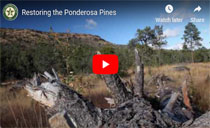 In 2014, Texas A&M Forest Service partnered with The Nature Conservancy to begin reforestation efforts on the Davis Mountains Preserve. Between 2015 and 2016, TFS received a 3-year $200,000 grant from USDA Forest Service for initial forest stand assessments and management prescriptions. Stands were marked and baseline data gathered in preparation for the thinning of 350 acres. Over 2,000 seedlings were planted in a site prep experiment, and as wildland planting. The wildland planting includes any seedlings that were planted outside of the pre-determined research sites
In 2014, Texas A&M Forest Service partnered with The Nature Conservancy to begin reforestation efforts on the Davis Mountains Preserve. Between 2015 and 2016, TFS received a 3-year $200,000 grant from USDA Forest Service for initial forest stand assessments and management prescriptions. Stands were marked and baseline data gathered in preparation for the thinning of 350 acres. Over 2,000 seedlings were planted in a site prep experiment, and as wildland planting. The wildland planting includes any seedlings that were planted outside of the pre-determined research sites
By:
USDA NRCS Texas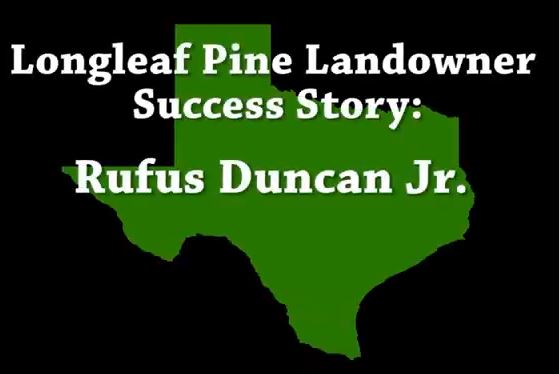 This video describes how Rufus Duncan is helping restore the historic Longleaf Pine range at Scrappin' Valley in east Texas.
This video describes how Rufus Duncan is helping restore the historic Longleaf Pine range at Scrappin' Valley in east Texas.
By:
USDA NRCS Texas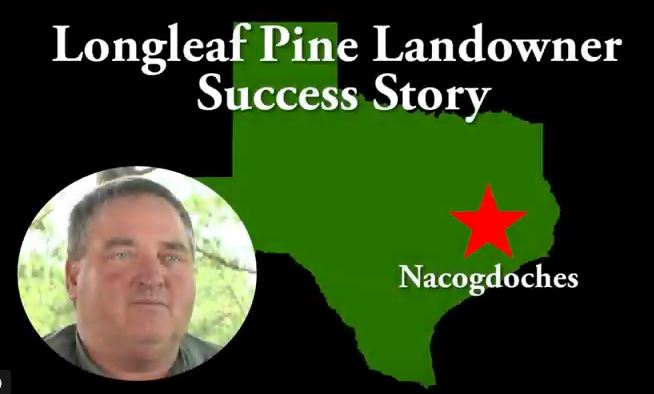 Simon Winston is restoring Longleaf Pine to his ranch near Nacogdoches Texas. Simon has received technical and financial assistance from many sources including the USDA Natural Resources Conservation Service, the US Fish and Wildlife Service, the National Wild Turkey Federation, Texas Parks and Wildlife Department and the Texas Longleaf Taskforce. Simon uses frequent prescribed burns to create favorable wildlife habitat and enhance the longleaf ecosystem
Simon Winston is restoring Longleaf Pine to his ranch near Nacogdoches Texas. Simon has received technical and financial assistance from many sources including the USDA Natural Resources Conservation Service, the US Fish and Wildlife Service, the National Wild Turkey Federation, Texas Parks and Wildlife Department and the Texas Longleaf Taskforce. Simon uses frequent prescribed burns to create favorable wildlife habitat and enhance the longleaf ecosystem
By:
USDA NRCS This Success Story highlights East Texas landowner Lloyd Gillespie's efforts to bring back Longleaf Pines to Scrappin' Valley.
This Success Story highlights East Texas landowner Lloyd Gillespie's efforts to bring back Longleaf Pines to Scrappin' Valley.
By:
USDA NRCS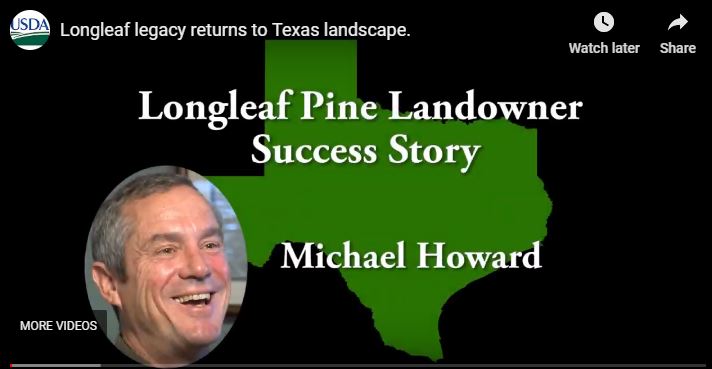 Mike Howard is a landowner in Sabine County and is restoring Longleaf Pines on his property.
Mike Howard is a landowner in Sabine County and is restoring Longleaf Pines on his property.
By:
Ben Ikenson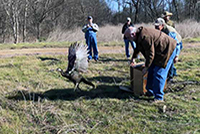 Texas Lawyer transformed part of Prairie Creek into a habitat where river otter, white-tailed deer and other wildlife thrive
Texas Lawyer transformed part of Prairie Creek into a habitat where river otter, white-tailed deer and other wildlife thrive